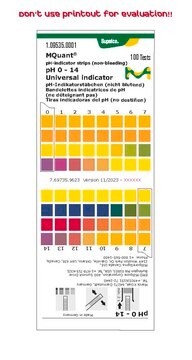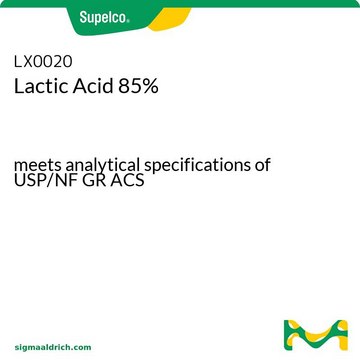Wichtige Dokumente
W261114
Milchsäure
natural, ≥85%
Synonym(e):
DL-Milchsäure, 2-Hydroxypropionsäure
About This Item
Empfohlene Produkte
Qualität
Fragrance grade
Halal
Kosher
natural
Agentur
follows IFRA guidelines
Einhaltung gesetzlicher Vorschriften
EU Regulation 1223/2009
FDA 21 CFR 117
Assay
≥85%
Form
liquid
Grünere Alternativprodukt-Eigenschaften
Less Hazardous Chemical Syntheses
Use of Renewable Feedstocks
Learn more about the Principles of Green Chemistry.
sustainability
Greener Alternative Product
Brechungsindex
n20/D 1.425 (lit.)
pH-Wert
2
bp
122 °C/15 mmHg (lit.)
Dichte
1.209 g/mL at 25 °C (lit.)
Kationenspuren
As: ≤3 ppm
Cd: ≤1 ppm
Fe: ≤10.0 ppm
Hg: ≤1 ppm
Pb: ≤10 ppm
Anwendung(en)
flavors and fragrances
Dokumentation
see Safety & Documentation for available documents
Nahrungsmittelallergen
no known allergens
Allergener Duftstoff
no known allergens
Grünere Alternativprodukt-Kategorie
, Aligned
Organoleptisch
odorless
SMILES String
CC(O)C(O)=O
InChI
1S/C3H6O3/c1-2(4)3(5)6/h2,4H,1H3,(H,5,6)
InChIKey
JVTAAEKCZFNVCJ-UHFFFAOYSA-N
Suchen Sie nach ähnlichen Produkten? Aufrufen Leitfaden zum Produktvergleich
Verwandte Kategorien
Allgemeine Beschreibung
Haftungsausschluss
Signalwort
Danger
H-Sätze
Gefahreneinstufungen
Eye Dam. 1 - Skin Corr. 1C
Zusätzliche Gefahrenhinweise
Lagerklassenschlüssel
8A - Combustible corrosive hazardous materials
WGK
WGK 1
Flammpunkt (°F)
235.4 °F - closed cup
Flammpunkt (°C)
113 °C - closed cup
Persönliche Schutzausrüstung
Eyeshields, Gloves, type ABEK (EN14387) respirator filter
Hier finden Sie alle aktuellen Versionen:
Besitzen Sie dieses Produkt bereits?
In der Dokumentenbibliothek finden Sie die Dokumentation zu den Produkten, die Sie kürzlich erworben haben.
Kunden haben sich ebenfalls angesehen
Global Trade Item Number
| SKU | GTIN |
|---|---|
| W261114-5KG | |
| W261114-SAMPLE | |
| W261114-10KG | |
| W261114-10KG-K | 4061838257130 |
| W261114-1KG-K | 4061838257147 |
| W261114-5KG-K | 4061838180568 |
| W261114-SAMPLE-K | 4061837515620 |
Unser Team von Wissenschaftlern verfügt über Erfahrung in allen Forschungsbereichen einschließlich Life Science, Materialwissenschaften, chemischer Synthese, Chromatographie, Analytik und vielen mehr..
Setzen Sie sich mit dem technischen Dienst in Verbindung.





